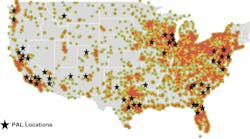Two overarching themes will dominate trucking's near-term future, according to experts and fleet executives gathered for the FTR Associates 2010 Transportation Conference in Indianapolis. The first is that truck freight volumes will continue to increase, which, when placed alongside a continued dearth of capacity, means rates will also rise.
The second theme, however, is starker, explained Noël Perry, principal of research firm Transport Fundamentals and senior consultant with FTR. The trucking business environment will be much more difficult than ever experienced in the past, he said.
“We are in a happy time for trucking, and it will probably get better even though monthly truck freight volumes continue to swing, showing the effect of the general economic ‘pause’ we're experiencing,” Perry said. “However, we are still way below the previous freight peak [of 2006] and it will take us until at least 2013 to get back to it.”
Still, with active truck capacity very tight — running about 94%, according to FTR's data — truckers should be in a position to profit from a projected 4 to 5% growth in freight expected through next year, Perry said.
Scott Arves, president &CEO of truckload carrier Transport America, said most fleets are trying to work their way back to the 9% margins they last experienced in 2006 and won't add capacity until reaching that target.
Perry believes average rate hikes of 10 to 12%, before fuel surcharges, are possible as fleets prepare to deal with other challenges, notably a driver shortage, the costs of regulatory compliance, and the hefty price tag for new equipment.
Fleets will also have to shell out more to attract drivers, said Max Fuller, co-chairman of TL carrier U.S. Xpress Enterprises. For example, to just increase his driver corps by 5% today, Fuller said it would require a base pay increase of 4 to 6¢ per mile plus a $5,000 sign-on bonus.


